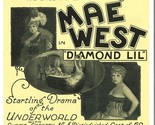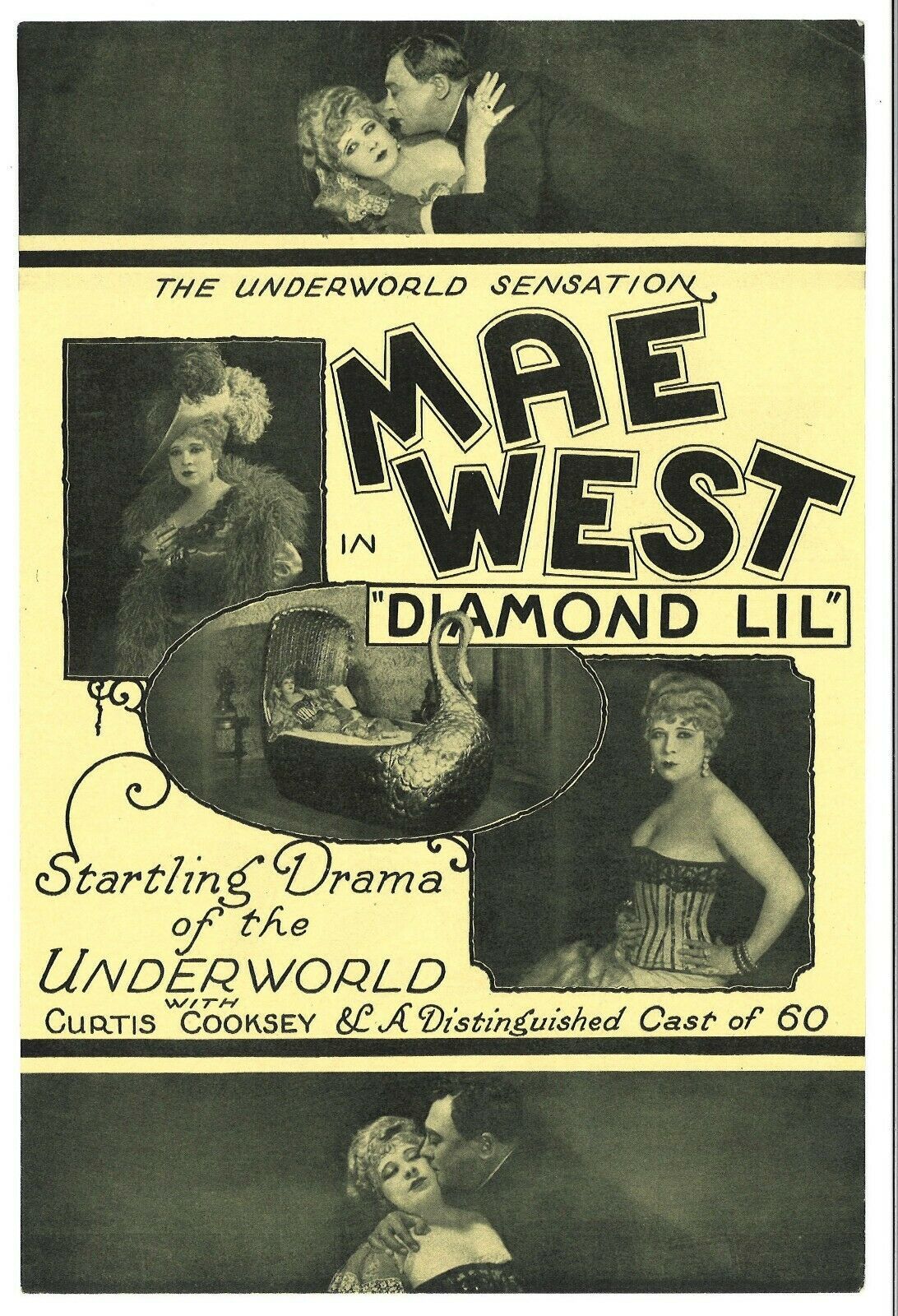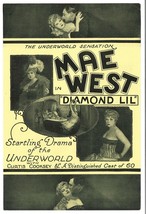Rendered at 16:29:50 05/30/25
*DIAMOND LIL (1928) Vintg Orig Double-Sided Theatrical Herald ESTATE OF MAE WEST
$295.00
Shipping options
Offer policy
OBO - Seller accepts offers on this item.
Details
Return policy
Refunds available: See booth/item description for details
Details
Purchase protection
Payment options
PayPal accepted
PayPal Credit accepted
Venmo accepted
PayPal, MasterCard, Visa, Discover, and American Express accepted
Maestro accepted
Amazon Pay accepted
Nuvei accepted
Shipping options
Offer policy
OBO - Seller accepts offers on this item.
Details
Return policy
Refunds available: See booth/item description for details
Details
Purchase protection
Payment options
PayPal accepted
PayPal Credit accepted
Venmo accepted
PayPal, MasterCard, Visa, Discover, and American Express accepted
Maestro accepted
Amazon Pay accepted
Nuvei accepted
Item traits
| Category: | |
|---|---|
| Quantity Available: |
Only one in stock, order soon |
| Condition: |
Unspecified by seller, may be new. |
| Original/Reproduction: |
Original |
| Country/Region of Manufacture: |
United States |
| Item Number: |
CS-DIAMOND-HER2 |
| Theatrical Production: |
Diamond Lil |
| LOC: |
YB-3R |
| Theatre: |
Royale Theatre (New York City) |
| Provenance: |
The Estate of Mae West |
| Modified Item: |
No |
| Year: |
1928 |
| Actors: |
Mae West, Curtis Cooksey |
| Item: |
Vintage original 6x9 double-sided herald |
Listing details
| Seller policies: | |
|---|---|
| Shipping discount: |
No combined shipping offered |
| Posted for sale: |
More than a week ago |
| Item number: |
741751310 |
Item description
From the Estate of Mae West is a very rare vintage original 6 x 9 inch double-sided herald from her racy and controversial 1928 New York theatrical production of DIAMOND LIL, a "Melodrama of the Underworld." The front side depicts two shots Mae West as "Diamond Lil" wearing two different-style period costumes; the center image depicts Mae living the life of gaudy luxury while reclining in a gold "swan" bed; and the top and bottom images depict Diamond Lil receiving the unwanted but tolerated affections of the "Boss of the Bowery" (Curtis Cooksey, who is really undercover police Captain Cummings), who provides for her lavish lifestyle. The other side depicts a portrait of Mae rendered within a star and notes that the play is presented at the Royale Theatre on 45th Street West of Broadway) and is presented "With a Distinguished Cast of 60."
This vintage original herald was issued for the play's original 1928 theatrical production and is not from a later-period production, nor is it a reproduction/copy or an intended fake. It is in very fine condition with only a light 0.5 in. diagonal crease on the top right corner (when viewing the front) and no pinholes, tears, stains, or other flaws. Vintage original material of any kind from the original 1928 run of this theatrical play is extremely scarce...and this herald is from Miss West's personal collection.
Diamond Lil is a 1928 play
by actress and playwright Mae West. Prior to Diamond Lil, she had written a number of
plays that were closed down due to either poor ticket sales or censorship
issues with the establishments of the time, despite the fact that many
high-ranking officials attended these plays. Diamond Lil, about a racy
woman in the 1890’s, was her first major Broadway success and was the basis for
her character “Lady Lou” in her 1933 film, She Done Him Wrong. Both West and the play were the final
performers at the Nixon Theater in Pittsburgh, Pennsylvania before
the theater was closed for a skyscraper development on April 29, 1950.
There is one woman Mae West kept close to
her for most of her career — and that was Diamond Lil. Mae was onstage,
performing in that show in October 1928, when her other play, Pleasure Man, was
raided two blocks away at the Biltmore Theatre and the police came to the
Royale Theatre to arrest her. What was
it about this character that captured Mae's fancy? In Mae's telling, the Queen
of the Bowery was a diamond-draped prostitute, a singer in a gin joint, and the
live-in lover of the Boss of the Bowery. The man in Lil's life, who showered
her with jewels and furs, was Gus Jordan, a candidate for sheriff and a sex
trafficker who operated from his saloon on Chatham Square. When "Diamond
Lil" came to life onstage in 1928, the setting was New York City's Bowery
during the 1890's.
Mae West was living in a West 54th Street hotel
when she first heard the folk song “Frankie and Johnny,” inspired by St. Louis
prostitute and “sporting queen” Frankie Baker (1876—1952). This African-American beauty,
known for diamonds “as big as hen’s eggs,” shot her lover with a .32-caliber
pistol on October 15, 1899. Though the ballad by Bill Dooley (a black “bar-room
bard”) concludes with Frankie Baker at the gallows, in reality, her murder
trial in Missouri ended in an acquittal. In 1928, Mae West and her
collaborator, Adeline Leitzbach, began working on a play for a cast of 33
actors that was set in the Bowery during the Naughty Nineties. Mae correctly
figured that the American theatre-goer, tired of living under the dry
restrictions of Prohibition, would welcome a “melodrama of the underworld” that
took place during a friskier era when a nickel bought a generous glass of
beer.
For authenticity, Diamond Lil has characters
based on real individuals, such as Bowery Boss “Big Tim” Sullivan (1862—1913) and Chuck Connors (1852—1913), the “Mayor of Chinatown.” Mae West cast Chuck
Connors, Jr. to play his father for the Broadway debut of Diamond Lil on
April 9, 1928. “Frankie and Johnny” became Mae West’s trademark song, featured
in her 66-minute film, She Done Him Wrong (1933), many recordings, and her
stage shows. Her three-act (3 hour) play, Diamond Lil, had several tours
between 1928—1951. Miss West, who never used an understudy, missed only two
performances, once due to influenza and once because she broke her
ankle.
Added to your wish list!

- *DIAMOND LIL (1928) Vintg Orig Double-Sided Theatrical Herald ESTATE OF MAE WEST
- 1 in stock
- Price negotiable
- Handling time 2 days. Estimated delivery: Thu, Jun 12th
- Returns/refunds accepted
Get an item reminder
We'll email you a link to your item now and follow up with a single reminder (if you'd like one). That's it! No spam, no hassle.
Already have an account?
Log in and add this item to your wish list.






